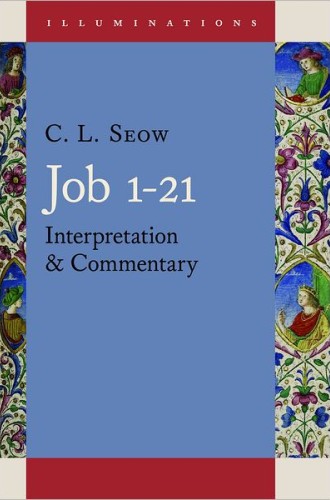The many Jobs
This massive commentary launches the Illuminations series, which aims to guide clergy and lay readers of the Bible while also providing technical detail for scholars. C. L. Seow, who teaches Old Testament language and literature at Princeton Theological Seminary, explores how the book of Job might have been understood by its original writers and audiences and how we might think about it now. He also describes how Job has been read, preached, painted, sung, and retold by Jews, Christians, Muslims, and secular interpreters between then and now. Seow accomplishes these ambitious goals surprisingly well. If you just want quick tips on preaching lectionary passages, this is probably not the commentary for you. But if you seek a sustained encounter with a particularly challenging book of the Bible, you’ll find Seow’s work a treasure.
The book of Job suits the approach of the Illuminations series particularly well because it has a rich and complex history of interpretation. However, because interpretation of details in Job is affected by one’s interpretation of the book as a whole, I wondered how useful it would be to have a volume that covers only the first 21 of Job’s 42 chapters. Fortunately, a larger perspective is supplied by this volume’s first 248 pages, in which the overall characteristics and interpretive history of the book are discussed.
Read our latest issue or browse back issues.
I encourage readers—especially those who know a bit about biblical scholarship—to at least skim the introduction. You needn’t linger on the discussion of Hebrew grammatical forms, but you might find it useful to learn that the oldest Greek translation of Job omitted about a sixth of the book, leaving out many confusing and troubling lines to produce a more orthodox and less shocking story. This information helps readers understand why early Greek-reading interpreters often saw in the text a more pious Job than we do.
The introductory discussions of genre, artistry, theology, and in particular the “History of Consequences” are especially relevant to understanding Job as a whole (here, too, readers should feel free to skip technical sections). The very language and format of the book invite multiple interpretations. As a character, Job has been most commonly understood as a model of faithful persistence, but some have seen a more rebellious Job, whom they have variously praised or condemned. Regardless of whether you grew up hearing about Job as a model of patience or as a legitimator of stormy questions to God, Seow’s summary of the interpretive history will alert you to wider possibilities.
Seow does not fully reveal his own interpretation of Job in the introduction, but he does give some hints. For example, he suggests that the wisdom hymn in Job 28 and Elihu’s speeches in Job 32–37 are from the same author as the rest of the book, and his supporting arguments for this position hint that he may want us to take Elihu’s criticisms of Job more seriously than have most recent interpreters—who tend to belittle Elihu as an arrogant upstart, the least sympathetic of all Job’s friends.
On the other hand, Seow describes Job’s “climactic statement” in 42:6 as “utterly ambiguous, thus open-ended.” (The verse is most often translated with something along the lines of the New Revised Standard Version’s “therefore I despise myself, and repent in dust and ashes,” but the Hebrew can be understood in many other ways, including the Common English Bible’s “therefore, I relent and find comfort on dust and ashes.”) Seow’s judgment that the ambiguity of this verse prevents closure, along with his attention to seemingly deliberate puns and ambiguities throughout the book, suggest that he does not believe that there is a single correct interpretation for the book of Job.
The commentary proper is organized by biblical chapter. Each section begins with Seow’s own translation, which sometimes sounds awkward because it follows the Hebrew structure so closely. For instance, Job 2:8: “Then Job took for himself a potsherd to scrape himself with it as he was sitting amidst the ashes.” But he also captures nuances quite beautifully, as in 2:9, where Job’s wife says, “Are you still holding on to your integrity? ‘Bless’ God and die!” Here (and in 1:5, 1:11, and 2:5) we find a Hebrew word that ordinarily would be translated bless but which in context seems to mean curse. Seow’s bless with scare quotes helps the English reader understand what is going on and thus follow the very interesting discussion about Job’s wife.
Each translation is followed by an interpretation that presents Seow’s best judgment about how to understand the text. These interpretations are directed to nonspecialists, but they are not simplistic. Repeatedly he calls attention to puns and ambiguities and their possible theological significance. He also offers a rich array of pointers to connections with other biblical texts. For instance, in discussing Job 12 he shows multiple connections with Psalm 107, Daniel, and Isaiah. He takes time to explain the significance of the parallels: in this case, Job’s phrasing draws on traditional praise language but always in a negative sense, making Job’s speech even more bitter than it would be without the allusions. Each interpretation contains a “History of Consequences” sidebar with tidbits about interpretation through the centuries. I hope that these sidebars will lure readers into the more extensive “History of Consequences” in the introduction.
Concluding the commentary on each chapter is a one-to-two paragraph “Retrospect” section that highlights an overarching theological theme for the chapter. For example, Seow concludes that in Job 3 “Job has not cursed God,” but “the question of human interiority remains.” With regard to Job 8, Seow denies that Bildad is “a shallow ideologue,” yet says that his theology “may need to be nuanced and otherwise corrected.” The retrospective comment on Job 16 suggests that Job “gives voice to those throughout history who suffer intolerable violence and gross injustice.” These brief summaries offer useful angles for preaching, although it is necessary to read the preceding interpretive sections to do them justice.
Seow concludes his discussion of each chapter of Job with phrase-by-phrase information about the texts and translation, along with a bibliography. These sections will be of more interest to scholars than to lay readers. Seow does, however, transliterate ancient words and supply their meanings, so if his translation or interpretive discussion piques your interest in a particular bit of wordplay, you can go here for a sense of the underlying sounds and meanings.
No commentary can accomplish everything, but there are two points at which I wish this ambitious volume had gone farther. First, I wish that the sidebars said more about the relationship between context and interpretation: Why do interpreters in a particular historical context tend to read in a particular way? At some points Seow does get at this question—for instance, in the discussion of early medieval Jewish interpretation in the Islamic East, northern Africa, and southern Europe—but more along these lines would have been helpful. Second, although the commentary does include 31 black-and-white images, visual and musical treatments of Job are for the most part simply mentioned, with bibliographical information given for those who wish to follow up. I would have liked to hear more about how such interpretations may broaden, deepen, or change our understandings of Job.
Seow’s commentary will not answer all your questions about Job, but it will help you appreciate how the book’s complex poetry reinforces its insistent questions. For professional scholars, Seow provides a wonderful entry into the massive literature on Job. For pastors and lay readers, he serves up a nourishing banquet of linguistic insight, historical perspective, and thoughtful theological reflection.







